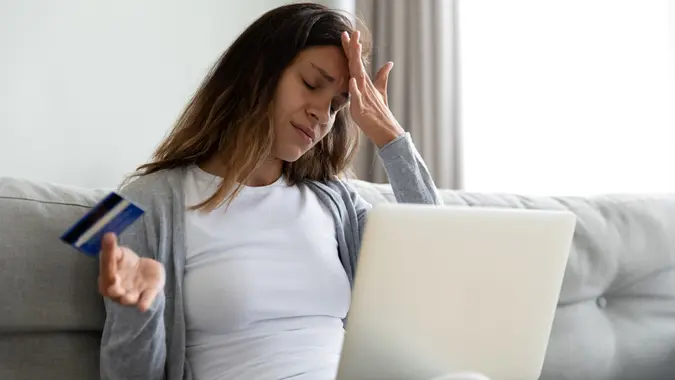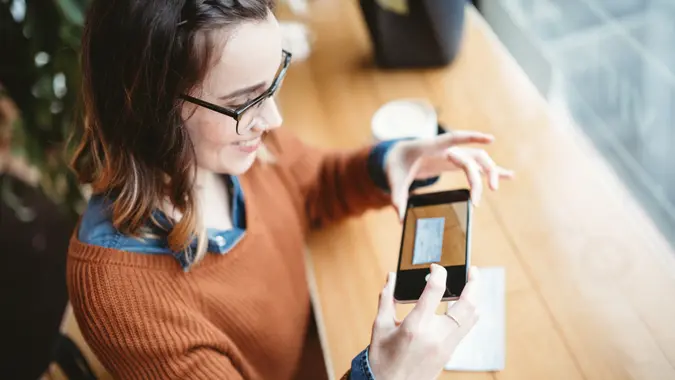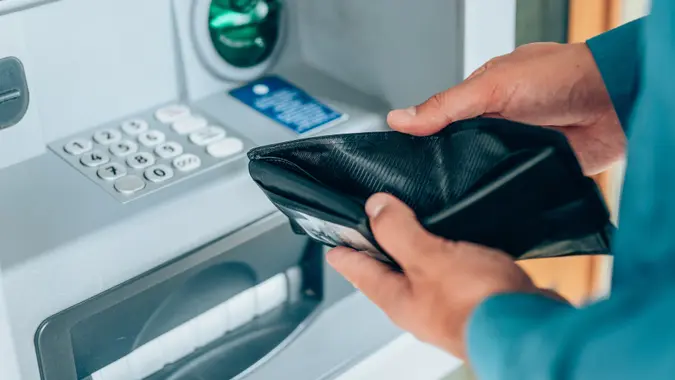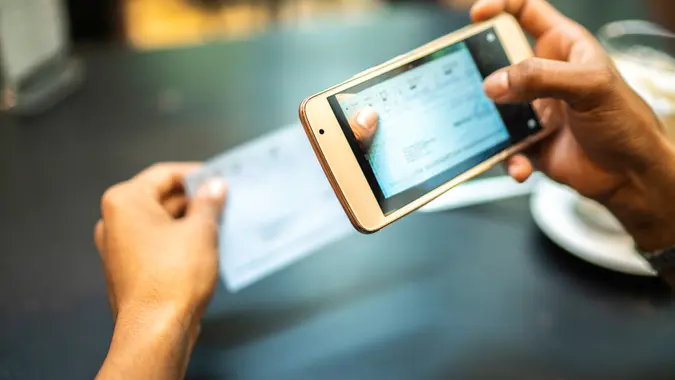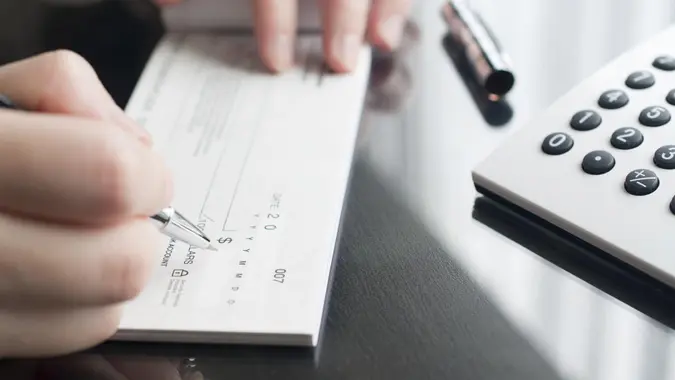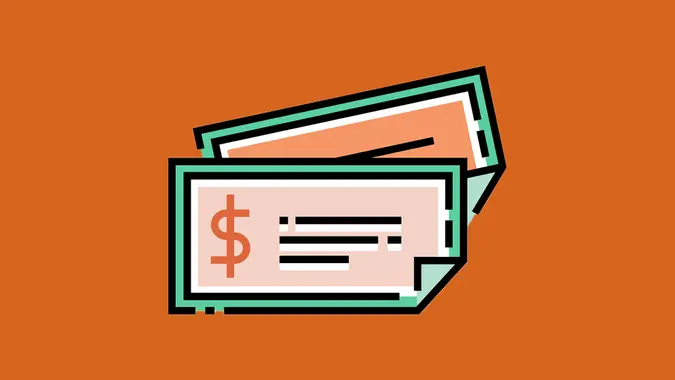How To Get a Debit Card: A Step-by-Step Guide

Commitment to Our Readers
GOBankingRates' editorial team is committed to bringing you unbiased reviews and information. We use data-driven methodologies to evaluate financial products and services - our reviews and ratings are not influenced by advertisers. You can read more about our editorial guidelines and our products and services review methodology.

20 Years
Helping You Live Richer

Reviewed
by Experts

Trusted by
Millions of Readers
The debit card is convenient and versatile. It lives in the front pocket in many wallets, and it’s easy to see why.
You can use it to make purchases or withdraw cash, and it’s accepted just about anywhere. Plus, because you’re using it to access funds you already have, you don’t have to worry about accumulating interest as you would with a credit card.
Knowing how to get a debit card may appear challenging, especially for those new to banking. However, the process to get a debit card is quite straightforward and requires a few simple steps.
What Is a Debit Card?
A debit card is linked to your checking account and allows you to make purchases or withdraw cash directly from your account.
Unlike credit cards, debit cards don’t involve borrowing money. They simply provide an easy and fast way to access your own funds. They are also slightly different from prepaid debit cards, which allow you to spend a specific amount of money that you’ve loaded onto a card.
How To Get a Debit Card: Step-by-Step
Getting a debit card is a simple step, but the most important when you’re looking to manage your finances. Follow these steps below:
1. Open a Bank Account
The first step to getting a debit card is to open an account at a bank or credit union. Debit cards are typically linked to checking accounts, so start by focusing on this type of account. Look for financial institutions that offer favorable features, such as low fees, convenient ATM locations and low required minimum deposits. You can start with GOBankingRates’ Best Banks for 2025.
If you’d prefer to do most of your banking at the same institution, you may also want to look at the interest rates the bank pays on savings accounts or CD accounts.
You may be able to open a checking account online or in person, although some banks may only offer one option. You’ll likely need to provide several documents:
- Driver’s license or other government-issued photo ID
- Proof of address, such as a utility bill
- Opening deposit, which can usually be made using check, cash or transfer from another account
2. Applying for a Debit Card
Once your checking account is set up, the next step is to request a debit card. In many cases, the bank will automatically issue a debit card when you open a new account. If not, you can request one either in person at a bank branch, over the phone or through the bank’s online banking platform.
3. Receiving Your Debit Card
Although some banks provide immediate access to debit cards, in most cases, you can expect to receive your debit card by mail in about a week. Once you’ve received your debit card, you’ll need to activate it before you can begin using it. Most debit cards come with instructions for activation, which can usually be completed in minutes either by phone or online.
4. Setting a PIN
You’ll need to set up a personal identification number, or PIN, for your debit card. This number code — usually four digits — is what you’ll be asked to enter when withdrawing money from an ATM or when making some purchases.
Your debit card may come with a PIN that your bank has already attached to it, or you may need to create your own PIN. You’ll typically be given instructions for how to set your PIN when you activate your card. Choose a PIN that is difficult for others to guess.
Types of Debit Cards
As you’re learning more about how to get a debit card, here’s an overview of the different types available:
Standard Debit Cards
A standard debit card is the physical card linked to your bank account that you can use for everyday purchases, bill payments and ATM transactions. When you make a transaction using your debit card, funds are pulled directly from your bank account. You’ll need to enter a four-digit PIN for ATM withdrawals and many purchases.
Some debit cards may come with cashback incentives or other rewards. Unlike credit cards, which allow you to finance a purchase and pay it off over time, debit cards typically limit you to spending up to the balance in your bank account.
Prepaid Debit Cards
A prepaid debit card is a safe and convenient alternative to cash. You load the card with a certain amount of funds, then use the card for purchases online and at stores or withdrawals at ATMs. You can typically reload the card online or at an ATM or participating store.
While standard debit cards are linked to your bank account, prepaid debit cards function more like gift cards, allowing you to spend only up to the balance you have on the card. You don’t even have to have a bank account to use a prepaid debit card. This makes prepaid debit cards ideal for someone who wants to stick to a budget and protect against overspending.
One downside to prepaid debit cards is that many charge a wide assortment of fees, ranging from activation fees to monthly fees to transaction fees. There may also be limits to how much money you can load onto the card.
Digital Debit Cards
Many banks provide you with a digital debit card, which can be used instead of or in addition to your physical debit card. You can access these virtual debit cards through your bank’s mobile app or add them to your smartphone’s digital wallet, such as Apple Pay or Google Wallet.
Digital debit cards offer additional convenience and security. They allow you to make purchases online or in person with a quick tap or click without having to carry around a physical card that could get lost or stolen. Digital wallets also use an enhanced security feature called tokenization, which creates a one-time code that is used for each purchase, so your actual debit card number stays protected.
Digital debit cards do have several limitations. You’ll still need to use your physical debit card to make transactions at an ATM, and some merchants don’t accept digital payments.
Benefits of Using a Debit Card
Debit cards offer several advantages over other payment types, such as credit cards, checks or cash.
- Immediate access to funds: Debit cards provide you with a direct link to your bank account, allowing you to withdraw money quickly and conveniently.
- No interest charges: While credit cards may offer you higher spending limits, you’ll end up owing interest payments if you don’t pay off the balance each month. This isn’t a problem with a debit card, since you’re spending money you already have.
- Fraud protection: Many debit cards come with features designed to protect you from unauthorized transactions. Depending on the bank, these may include real-time alerts of suspicious activity or reimbursement for fraudulent use.
- Convenient transactions: Perhaps the most obvious benefit of a debit card is that it simplifies your everyday routine. A debit card eliminates the need to carry cash or write checks for purchases and it allows you to access your account at ATMs instead of visiting a bank branch.
Tips for Managing Your Debit Card Responsibly
Take a look at these tips to keep your debt in check.
Track Your Spending
A debit card can be a powerful tool for budgeting and tracking your spending. Since transactions are directly linked to your bank account, you can easily monitor where your money is going through online banking apps or statements. This can help you make more informed decisions about your spending habits.
Avoid Overdraft Fees
Some banks will allow you to make a purchase or withdrawal that results in a negative balance on your account. While this can provide temporary convenience, you’ll typically be charged an overdraft penalty of around $35. However, there are some steps you can take to prevent this from happening.
- Link accounts: You may be able to link your checking account to a savings account and have funds automatically transferred from one account to the other to cover a balance.
- Set low-balance alerts: Most banks’ mobile apps allow you to set up notifications alerting you when your balance falls below a certain level. You typically can choose to receive the alerts via text, email or notifications on your phone.
- Decline overdraft coverage: If you want to avoid overdraft fees at all costs, you can choose to opt out of the coverage. This will result in transactions being declined if you don’t have enough funds in your account.
Secure Your Card and PIN
A few simple precautions can keep your debit card from falling into the wrong hands.
- Protect your PIN: Never share your PIN with anyone and be cautious when entering it in public places.
- Use secure ATMs: Preferably use ATMs located at bank branches and avoid isolated or poorly lit ATMs for safety.
- Monitor account activity: Regularly check your transaction history online or in your bank’s mobile app and be sure you recognize all charges or activity.
Alternatives to Bank Account Debit Cards
Here are some options to consider as alternatives to debit cards issued by a bank.
- Prepaid debit cards
- Credit cards
- Cash
Final Take
Knowing how to get a debit card is your first step toward becoming financially savvy. By following these straightforward steps and using your card responsibly, you’ll be able to enjoy the benefits of easy access to your funds and smooth transactions.
Remember, a debit card is a powerful tool in managing your day-to-day finances, so use it wisely and always keep an eye on your money.
Debit Card FAQ
Here are the answers to some of the most frequently asked questions regarding debit cards.- What do I need to open a bank account to get a debit card?
- To open a bank account, you’ll typically need to provide a driver’s license or other government-issued photo ID, your Social Security number, proof of address and an opening deposit. You can request a debit card during the process of applying for a bank account.
- Can you get a debit card without having a checking account?
- Yes, there are several ways to get a debit card without opening a checking account. You can get a prepaid debit card that allows you to load funds onto the card. Another option is to get a debit card linked to a mobile payment app.
- How do I activate my debit card?
- When you receive your debit card, it will come with instructions for how to activate it. Activation can typically be completed online, over the phone or at an ATM.
- Are there fees for using my debit card?
- Debit cards can have various types of fees. These may include:
- ATM fee: You will likely be charged a fee for using ATMs outside of your bank’s network.
- Overdraft fee: An overdraft fee is a penalty is charged when you make a purchase or withdrawal that pulls out more funds than you have in your account.
- Replacement card fee: This is charged when you request a new card to replace one that was lost or stolen.
- Prepaid debit cards often charge additional fees for monthly use, activation and more.
- Debit cards can have various types of fees. These may include:
 Written by
Written by  Edited by
Edited by 



